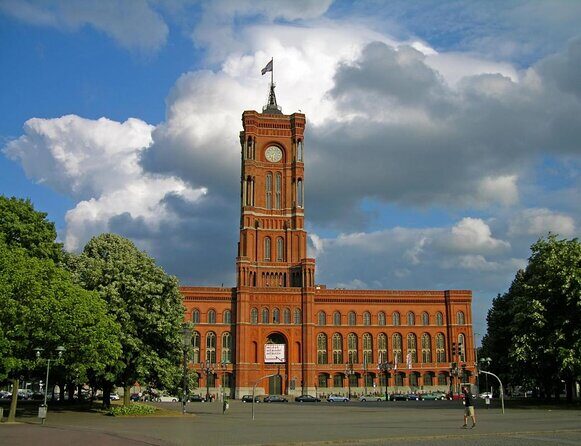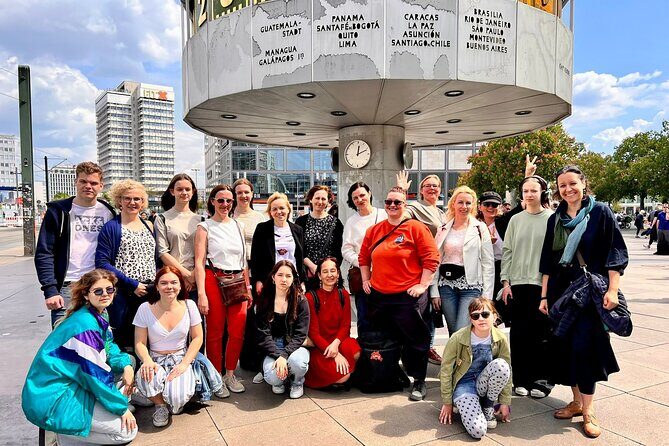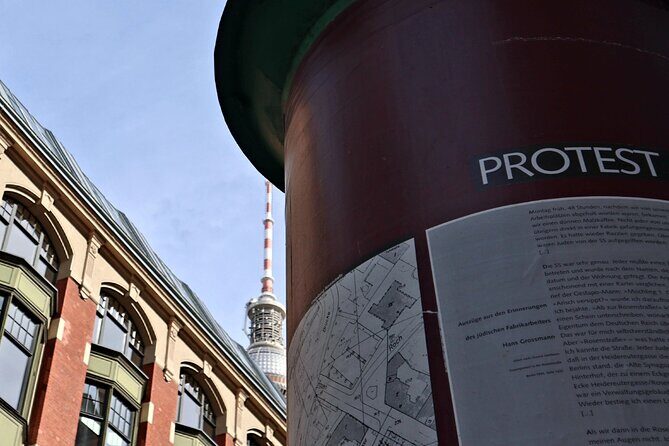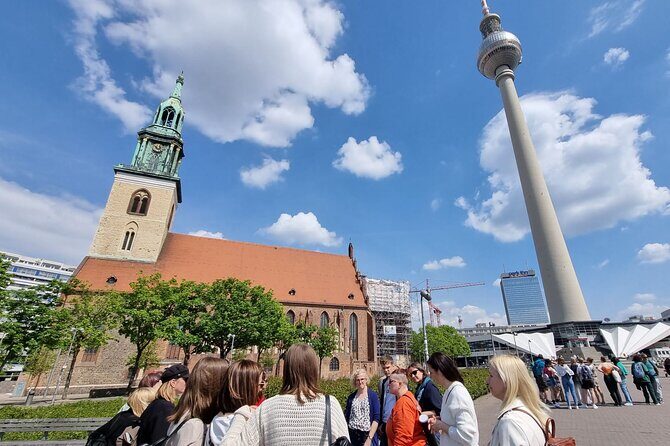Rebels, Resistance, and Revolution: Berlin Protest Walking Tour offers an eye-opening journey through Berlin’s turbulent history of protests and civil courage. For just $23, you’ll spend around two hours walking through some of the city’s most iconic spots, guided by passionate storytellers who bring Berlin’s rebellious past vividly to life. The tour is designed for those curious about the city’s political upheavals, from early uprisings to the fall of the Berlin Wall, all while soaking in the atmosphere of Alexanderplatz and its surroundings.
Two aspects particularly stand out: first, the way the guides bring history alive with spot-on details and thoughtful commentary; second, the chance to see lesser-known sites that reveal Berlin’s layered stories of resistance. While the tour covers a lot of ground—over eight stops—be prepared for a brisk walk that’s heavy on information but light on fatigue. One potential consideration is that the tour is most suited for history buffs or those with a genuine interest in civil courage, as some sites may be less immediately engaging without context.
This tour suits travelers who enjoy storytelling that combines history, politics, and cityscape, especially if you’re eager to see Berlin from a perspective that emphasizes its enduring spirit of protest and resilience. It’s perfect for visitors who appreciate depth over surface-level sightseeing, and who want a meaningful insight into how resistance shaped Berlin’s identity.
Key Points

- Authentic Focus: The tour emphasizes Berlin’s history of protests, uprisings, and civil courage, not just sightseeing.
- Expert Guides: Guides are highly praised for their knowledge and storytelling skills.
- Accessible Sites: The stops include well-known landmarks like Alexanderplatz and hidden stories like the Rosenstraße protest.
- Value for Money: At only $23, it offers a deep dive into Berlin’s political past in just two hours.
- Balance of Content: The tour balances historical facts with engaging stories, making complex history accessible.
- Walking Experience: The route is manageable and covers about 2 km, suitable for most fitness levels.
An In-Depth Look at the Protest and Resistance Tour

Berlin’s history as a city of rebellion is never far from the surface. From the Rotes Rathaus (Red Town Hall), with its terracotta murals depicting Berlin’s early history, to the Marx-Engels-Forum, where the statues of two socialist philosophers stand as symbols of ideological struggles, this tour paints a vivid picture of Berlin’s political transformations.
Stop 1: Rotes Rathaus is an ideal starting point. The guide explains how this impressive building, with its distinctive terracotta façade, reflects Berlin’s history of uprising and resilience. You’ll appreciate the way the history is woven into the architecture, giving an immediate sense of the city’s layered past.
Next, the Marx-Engels-Forum features statues that have sparked debate over the years, representing Berlin’s socialist past. The guide discusses how these symbols still echo the city’s ideological shifts, making it more than just a photo op.
A highlight is Stop 3: Humboldt Forum, where you see the reconstructed Berlin Palace. This site is significant because the original palace witnessed the March Revolution of 1848, a pivotal moment that ignited Germany’s push towards democracy. We loved the way the guide connected the physical rebuilding of the palace to Berlin’s ongoing struggle for identity and change.
Nikolaiviertel, built to celebrate Berlin’s 750th anniversary, offers a look at socialist kitsch and the last remnants of the Palace of the Republic—a symbol of East German socialism. It’s a reminder of how architecture was used as propaganda, and the guide points out how these structures still tell stories of ideological control.
The Mutter Hoppe tavern hosts a timeline of East German socialist history, notably missing the Berlin Wall’s construction—perhaps a telling omission. This stop reveals how history can be curated, sometimes with ideological bias.
Stop 6: St. Mary’s Church adds a spiritual dimension, where Martin Luther King delivered a historic sermon in 1964. The guide links this to ongoing struggles for freedom and civil rights, showing that Berlin’s resistance isn’t just political but also moral.
Rosenstraße is perhaps the most emotionally charged stop. The monument commemorates the courageous women who protested against Nazi policies in 1943, and the guide recounts how this was the only protest by Germans against the Final Solution. We appreciated the detailed storytelling—this is a powerful, lesser-known chapter of resistance.
Moving towards the Neptunbrunnen, the fountain becomes a symbol of nonviolent protest, with stories of oppositionists staging a “t-shirt protest” in autumn 1989, a key moment leading up to the fall of the Wall. The guide explains how youthful courage played a part in ending East Germany’s isolation.
You’ll catch a glimpse of Berlin’s Television Tower, built as a symbol of communist power, and the World Time Clock, a meeting point in East Berlin, which emphasizes the interconnectedness of the world and the longing for freedom.
If you're drawn to exploring Berlin on foot, we've looked into these other walking experiences
The Experience in Detail
The tour’s itinerary is well-curated, balancing prominent landmarks with sites that reveal Berlin’s underappreciated stories of resistance. Each stop typically lasts around 10-20 minutes, giving enough time for meaningful explanation without dragging on.
Stops like the Rotes Rathaus and Marx-Engels-Forum are essential for understanding Berlin’s socialist past. The guide’s explanations make these sites more than just visual landmarks—they become stories of ideological clashes and the city’s resilience.
The Humboldt Forum stands out because it’s a physical symbol of both reconstruction and remembrance. It’s fascinating to see how the original Berlin Palace was a witness to multiple protests, especially the 1848 revolution that helped shape Germany’s democracy. The guide’s contextualization of these events offers a rich understanding for history enthusiasts.
The Nikolaiviertel and Mutter Hoppe give insight into East Berlin’s attempt to craft a socialist identity through architecture and public history. These sites show how history is sometimes rewritten or curated, which adds an educational layer to the experience.
The Rosenstraße protest is a centerpiece for understanding civil disobedience during the Nazi era. The guide’s account of the women’s protest and the foundations of Berlin’s oldest synagogue deepen the emotional impact. The monument here is a reminder that even in the darkest times, ordinary people can muster extraordinary courage.
The Neptunbrunnen and Weltzeituhr are social hubs that symbolize Berlin’s unique urban culture. The stories of youth protests and East Berlin’s social life add a lively dimension to the tour.
Throughout, the small group size (maximum 15 travelers) creates an intimate environment where questions are encouraged, and stories can be personalized. The tour’s focus on walking makes for a personal experience that connects you directly with the city’s streets and stories.
Reviews highlight the guides’ deep knowledge and storytelling ability, often noting that even locals learn new things. One reviewer praised the tour for its well-researched details and depth, stating it’s especially rewarding for those who already know Berlin or are history-inclined.
Practical Tips and Considerations

The tour is priced very reasonably, especially given the depth of storytelling and the number of sites visited. At only $23, it provides excellent value for anyone interested in Berlin’s protests, revolutions, and civil courage.
The duration of about two hours makes it suitable for most travelers, though be prepared for a brisk pace. Wear comfortable shoes and plan for some outdoor exposure, as no indoor stops are included in the itinerary.
The meeting point is at the sculpture Aufbauhelferin near Rotes Rathaus, and the tour ends at the World Time Clock in Alexanderplatz. Both locations are easily accessible via public transportation, making it simple to plan your day around this experience.
The tour is free to cancel up to 24 hours in advance, providing flexibility for your travel plans.
Who Would Love This Tour?

This experience is perfect for history enthusiasts eager to see Berlin through the lens of protest and resistance. It’s also suited for curious travelers who want a deeper understanding of Berlin’s political past without spending hours in museums. If you’re interested in architecture that symbolizes political ideologies, or if you simply want to learn about the stories behind familiar landmarks, this tour will satisfy.
It’s especially valuable for visitors who appreciate guides with a passion for storytelling and enjoy discovering hidden stories behind well-known sites. The tour’s focus on civil courage makes it inspiring, and the stories of protest and resistance remain relevant today.
FAQ
Is this tour suitable for all ages?
Yes, most travelers can participate, and the stories are engaging for a wide age range. However, the content about protests and resistance might be more meaningful for older children or teens.
How long does the tour last?
Approximately two hours, covering about 2 km of walking and nine stops. It’s a brisk but manageable pace.
Do I need to book in advance?
Yes, the tour requires a mobile ticket reservation, and booking ahead ensures your spot, especially during peak seasons.
Is there an indoor component?
The tour is mostly outdoor, focusing on landmarks and monuments. Prepare for weather, and dress comfortably.
Can I cancel if my plans change?
Yes, full refund if canceled at least 24 hours before the start. Cancellations within 24 hours are not refunded.
Are children allowed?
Most travelers can participate; the stories are suitable for older kids, especially those interested in history and civil rights.
What makes this tour stand out compared to others?
Its focused narrative on protest history, expert guides, and visits to lesser-known sites that reveal Berlin’s resilience and activism.
To sum it up, the “Rebels, Resistance, and Revolution” walking tour is a compact yet powerful way to understand Berlin’s spirit of defiance. It balances historical depth with engaging storytelling, making it ideal for those who want more than just pictures of famous landmarks. With knowledgeable guides and a thoughtfully curated route, it offers a meaningful perspective on how protests shaped Berlin—and perhaps, how they continue to influence the city today. Whether you’re a history lover or just curious about the stories behind Berlin’s walls, this tour will leave you with a new appreciation for the city’s enduring fight for freedom.
- Discover Berlin Half-Day Walking Tour
- Third Reich Berlin: Hitler and WWII Walking Tour
- Berlin: Sachsenhausen Concentration Camp Tour in English
- Explore Berlin: Walking Tour of All The Iconic Sites
- Sachsenhausen Concentration Camp Memorial Tour with max 15 people
- Berlin Icebar Experience Including 3 drinks
More Walking Tours in Berlin
- Potsdam, City of Emperors Walking Tour
- Walking on the Wall: 3-Hour Tour in Berlin
- All-in-One Berlin Highlights on Foot: Private Walking Tour
- Berlin Cold War & World War II Third Reich Walking Tour
- The Real Berlin Walking Tour: Art, Food and Counterculture
- The History of Berlin: WWII PRIVATE Walking Tour With Locals
More Tours in Berlin
More Tour Reviews in Berlin
More Berlin experiences we've covered
- Berlin: Ultimate E-Scooter Adventure Tour
- Private Day Trip to Potsdam from Berlin by Train
- Potsdam, City of Emperors Walking Tour
- Walking on the Wall: 3-Hour Tour in Berlin
- Berlin Wall Self-Drive Trabi Tour
- Berlins Must-See History Sites Private Black Van Half-Day Tour
- Warnemuende Shore Excursion: Berlin Private Sightseeing Tour from Rostock
- All-in-One Berlin Highlights on Foot: Private Walking Tour
- Never Again Sachsenhausen Concentration Camp
- Historic Pubs of Berlin & Berlin Beer Tour
- Berlin Cold War & World War II Third Reich Walking Tour
- The Beauty of Berlin by Bike: Private Tour
